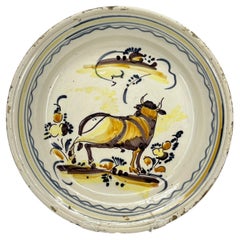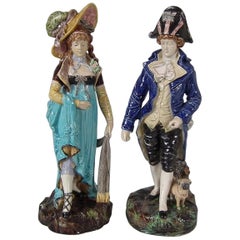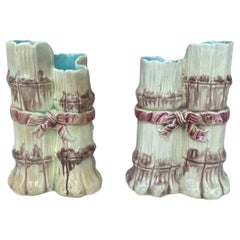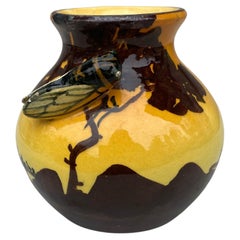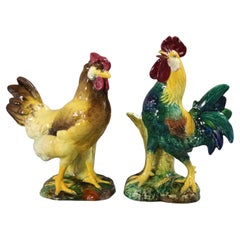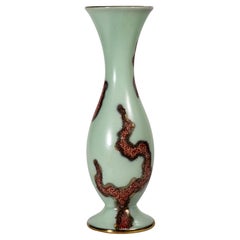Majolica Decorative Objects
Early 19th Century Spanish Folk Art Antique Majolica Decorative Objects
Ceramic, Majolica
1880s German Victorian Antique Majolica Decorative Objects
Majolica
1890s English Victorian Antique Majolica Decorative Objects
Ceramic, Faience, Majolica
1950s French Country Vintage Majolica Decorative Objects
Ceramic, Majolica
1910s Victorian Vintage Majolica Decorative Objects
Majolica
Mid-20th Century German Mid-Century Modern Majolica Decorative Objects
Ceramic, Majolica, Pottery
1890s French Rustic Antique Majolica Decorative Objects
Ceramic, Majolica
Mid-20th Century Italian Majolica Decorative Objects
Majolica
20th Century Spanish Mid-Century Modern Majolica Decorative Objects
Ceramic, Majolica
1890s French Aesthetic Movement Antique Majolica Decorative Objects
Majolica, Ceramic
Early 1900s French Art Nouveau Antique Majolica Decorative Objects
Ceramic, Faience, Majolica
1950s French Mid-Century Modern Vintage Majolica Decorative Objects
Ceramic, Faience, Majolica
1890s French Majolica Pottery Antique Majolica Decorative Objects
Majolica
Early 20th Century French Art Nouveau Majolica Decorative Objects
Gold
20th Century Spanish Mid-Century Modern Majolica Decorative Objects
Ceramic, Majolica, Earthenware
20th Century Majolica Decorative Objects
Majolica
1870s English Victorian Antique Majolica Decorative Objects
Ceramic, Faience, Majolica
1950s French Mid-Century Modern Vintage Majolica Decorative Objects
Majolica, Ceramic, Faience
1940s French Country Vintage Majolica Decorative Objects
Majolica, Ceramic
21st Century and Contemporary Italian Majolica Decorative Objects
Ceramic, Majolica
Mid-20th Century Italian Mid-Century Modern Majolica Decorative Objects
Ceramic, Majolica, Pottery
1880s German Rococo Revival Antique Majolica Decorative Objects
Ceramic, Majolica
1880s European Aesthetic Movement Antique Majolica Decorative Objects
Majolica, Ceramic
1880s French Victorian Antique Majolica Decorative Objects
Majolica
Late 19th Century Italian Antique Majolica Decorative Objects
Majolica
1880s French Art Nouveau Antique Majolica Decorative Objects
Majolica, Ceramic, Faience
1880s English High Victorian Antique Majolica Decorative Objects
Majolica, Pottery
1890s French Victorian Antique Majolica Decorative Objects
Ceramic, Majolica
1920s French Country Vintage Majolica Decorative Objects
Ceramic, Faience, Majolica
1950s French Mid-Century Modern Vintage Majolica Decorative Objects
Ceramic, Faience, Majolica
Mid-20th Century Unknown Chinoiserie Majolica Decorative Objects
Majolica
1880s French Rustic Antique Majolica Decorative Objects
Ceramic, Majolica
1880s French Aesthetic Movement Antique Majolica Decorative Objects
Ceramic, Faience, Majolica
Late 19th Century French Antique Majolica Decorative Objects
Ceramic, Majolica
Late 19th Century English Arts and Crafts Antique Majolica Decorative Objects
Majolica
19th Century English Victorian Antique Majolica Decorative Objects
Majolica
1910s French French Provincial Vintage Majolica Decorative Objects
Majolica, Ceramic
1880s French Renaissance Revival Antique Majolica Decorative Objects
Faience, Ceramic, Majolica
1880s French Renaissance Revival Antique Majolica Decorative Objects
Majolica, Ceramic, Faience
1880s French Romantic Antique Majolica Decorative Objects
Ceramic, Majolica
19th Century French Antique Majolica Decorative Objects
Majolica
Mid-20th Century Spanish Mid-Century Modern Majolica Decorative Objects
Ceramic, Majolica
1950s French Rustic Vintage Majolica Decorative Objects
Ceramic, Faience, Majolica, Pottery
19th Century French Art Nouveau Antique Majolica Decorative Objects
Majolica, Porcelain
19th Century Guatemalan Spanish Colonial Antique Majolica Decorative Objects
Majolica, Pottery
Mid-20th Century Ukrainian Mid-Century Modern Majolica Decorative Objects
Ceramic, Majolica
Mid-20th Century Italian Majolica Decorative Objects
Majolica, Terracotta
20th Century Italian Majolica Decorative Objects
Majolica
1880s French Aesthetic Movement Antique Majolica Decorative Objects
Ceramic, Faience, Majolica
Mid-20th Century Swedish Scandinavian Modern Majolica Decorative Objects
Ceramic, Majolica, Pottery
Late 19th Century English Victorian Antique Majolica Decorative Objects
Majolica
1990s Italian Renaissance Majolica Decorative Objects
Ceramic, Majolica
20th Century French Mid-Century Modern Majolica Decorative Objects
Ceramic, Majolica, Pottery
1850s French Renaissance Revival Antique Majolica Decorative Objects
Ceramic, Majolica
20th Century French Majolica Decorative Objects
Majolica, Porcelain
1890s French Art Nouveau Antique Majolica Decorative Objects
Ceramic, Faience, Majolica
1860s English Victorian Antique Majolica Decorative Objects
Majolica
Early 1900s French Victorian Antique Majolica Decorative Objects
Majolica
1890s French Victorian Antique Majolica Decorative Objects
Ceramic, Majolica
1890s French Country Antique Majolica Decorative Objects
Ceramic, Majolica
Antique and Vintage Majolica Vases, Bowls, Candleholders and Other Decorative Objects
The popularity of Victorian majolica, the gaily colored, metallic-oxide-glazed earthenware, has ebbed and flowed for more than a century. Right now, antique and vintage vases, bowls and other decorative objects appear to be having a moment — again.
Starting in the 1850s, people in the U.S. and the U.K. embraced these affordable housewares with unusual polychrome palettes (turquoise and pink) and whimsical forms (candlesticks shaped like dolphins). By the 1870s, majolica was being mass-produced for an ever-expanding middle class in countries like England, France, Sweden, Hungary and Portugal. Majolica was Art for Everyman. Its popularity coincided with interest in exotic Japonisme and scientific studies by the likes of Carl Linnaeus, Charles Darwin and John James Audobon.
Despite a similarity in name, Victorian majolica is significantly different in subject matter and form from its Italian forebear, Renaissance maiolica. That earlier earthenware bore gaily painted religious and mythological scenes, and unlike majolica, with its lively contours, was not molded or three dimensional.
What was the attraction of majolica for the 19th-century collector? “Imagine what it looked like in a Victorian interior, with dark woods, heavy drapes and upholstered chairs and sofas,” says Susan Weber, founder of the Bard Graduate Center in New York. “Majolica is robust and extremely tactile. With its naturalistic shapes, colorful glazes and often humorous themes, it appealed to the growing consumer society.”
In England, manufacturers like Minton began to produce decorative, relief-molded majolica tiles for the interiors of taverns, train stations, even the famous Queen’s Dairy at Frogmore, on the grounds of Windsor Castle. In 19th-century France, Sèvres and smaller ceramics firms began to reinterpret the snake-decorated platters made by Bernard Palissy, a 16th-century self-taught French potter. The result was a type of majolica called Palissy ware, which, like the originals, was festooned with odd creatures (lobsters, lizards and snakes) modeled by hand.
The late Moroccan-born, Paris-based decorator Alberto Pinto often placed Palissy ware in his clients’ living rooms, posing individual pieces on brackets against a background of stamped, gilded leather. Pinto, in turn, influenced such contemporary decorators as Harry Heissmann of New York. After 1900, people got swept up in the romanticism of Art Nouveau and ceased buying majolica. The 1970s saw a revival of interest, and in 1982, the Cooper Hewitt, Smithsonian Design Museum, in New York, organized “English Majolica,” an exhibition featuring 75 examples from Minton, Wedgwood and George Jones, among other makers.
On 1stDibs, find antique and vintage majolica tea sets, vases, candlesticks, tureens and other furniture and decorative objects.
Read More
How a Craving for Color Revolutionized Glass
After synthetic dyes changed fashion, home goods and printed matter, it was only a matter of time till glass caught up.
Kazuyo Sejima’s Flowering Tree Blooms Year-Round
The brilliantly simple design turns a modest bouquet into a major statement.
He Wrote ‘Oedipus Rex,’ but Do You Know What He Looked Like?
The Greek tragedian is said to have been handsome in his day.
Cigar Culture Was Once the Peak of Masculinity. Now, It’s a Compelling Curiosity
Even for those who don’t indulge, elegant smoking accessories and audacious art portraying cigar enthusiasts hold a nostalgic allure.
African Travel Plans on Hold? This Ardmore Leopard Vase Brings the Beauty of the Savanna to You
It’s an excellent example of the sought-after ceramics coming out of South Africa’s KwaZulu-Natal province.
With a High-Tech Flagship and Cool Collabs, Lladró Is Breaking the Mold for Porcelain Production
Thanks to its new leadership, the Spanish maker of figurines, busts and lighting is on a mission to update the art of porcelain for the 21st century.
Zoë Powell’s Magnolia 05 Vessel Is Handmade from Clay She Unearthed Herself
The free-form stoneware piece is inspired by the magnolia tree and its associations with home.
8 Ways to Breathe New Life into a Space with Plants
The pair behind the Instagram account @houseplantclub share their tips for making any room of the house gloriously green.
